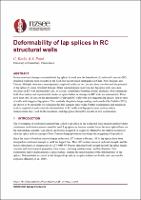| dc.description.abstract | Severe structural damage associated with lap splices located near the foundation of reinforced concrete (RC) structural walls has been recorded in the field after recent major earthquakes in Chile, New Zealand, and Taiwan. Multiple laboratory investigations completed in the last two decades have corroborated the potential of lap splices to cause structural damage. Strain concentrations occurring near lap splice ends can cause decreases in RC wall deformability and, as a result, compromise building seismic resilience. Post-earthquake field observations and experimental studies of splice failure or damages in RC walls are summarized. There have been only 20 tests on the deformability of flexural RC walls with non-staggered lap splices, and no tests of walls with staggered lap splices. Two methods, the plastic-hinge analogy and a method by Pollalis (2021), are shown to be unreliable for estimating the drift capacity these walls. Further experimental and numerical work is required to understand the deformability of RC walls with lap splices near sections where reinforcement may yield. In the meantime, such lap splices should be avoided in new construction. | |

